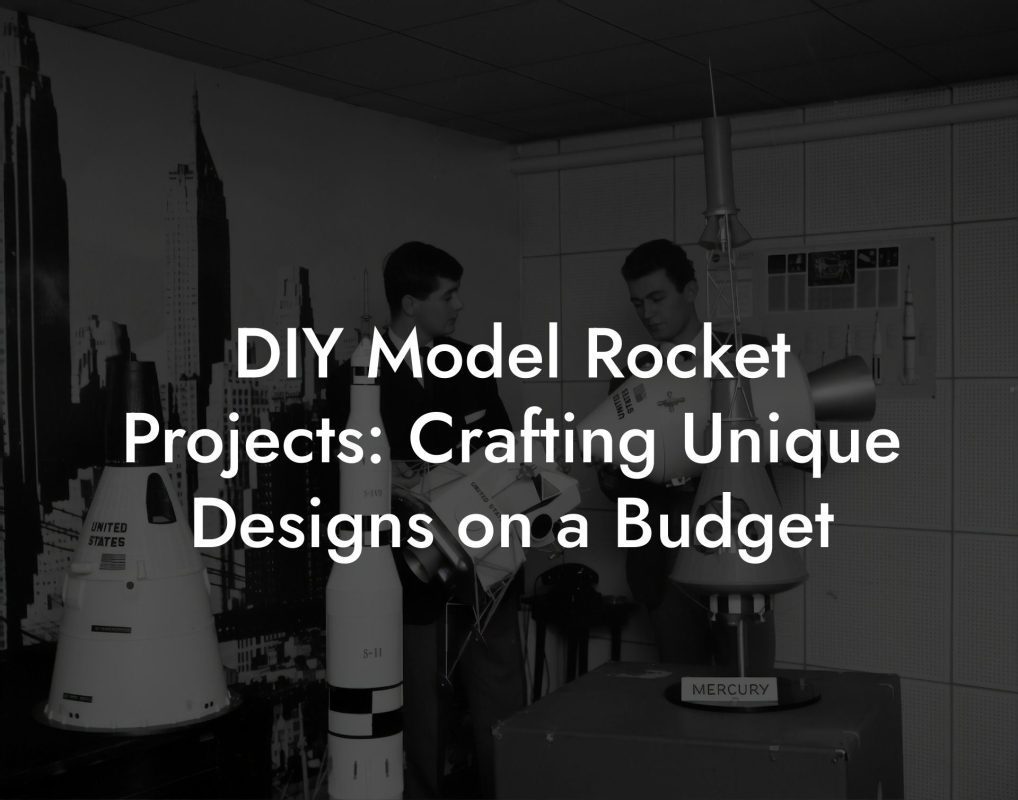Modular rocketry transforms the way you build, test, and upgrade your model rockets by enabling interchangeable components that adapt to your evolving creative vision. "Modular Rocketry: Creating Rockets with Interchangeable Components" is your in-depth guide to designing flexible, scalable rockets that let you swap out engines, fins, payloads, and more. Whether you’re looking to optimize performance, experiment with new technologies, or simply enjoy the ease of upgrading your design over time, this guide will show you how to create a rocket system that grows with your passion.
Quick Links to Useful Sections
- Introduction: Embracing the Modular Revolution
- Benefits of Modular Rocketry
- Designing for Modularity: Key Principles and Strategies
- Standardized Interfaces
- Interchangeable Components
- Scalability and Future Upgrades
- Aerodynamic Integration
- Materials and Tools for Modular Rocketry
- Materials
- Essential Tools
- Assembling a Modular Rocket: Step-by-Step Process
- Step 1: Design and Prototype Individual Modules
- Step 2: Establish Standard Interfaces
- Step 3: Assemble Individual Components
- Step 4: Integrate Modules into a Complete System
- Step 5: Final Assembly and Testing
- Maintenance and Upgradability: The Modular Advantage
- Model Rocketry FAQs: Modular Rocketry
- Your Next Launch: Innovate, Upgrade, and Reach New Heights
Introduction: Embracing the Modular Revolution
The world of model rocketry is no longer confined to fixed designs and one-time builds. Modular rocketry opens up a realm of possibilities by allowing you to create rockets with interchangeable parts. This innovative approach not only simplifies the process of testing different configurations but also enables rapid prototyping, easier repairs, and continuous performance upgrades. In this guide, we’ll explore the principles behind modular designs, the benefits they offer, and the practical steps you can take to build a modular rocket that meets your goals.
With a modular approach, every launch becomes an opportunity to learn, iterate, and improve. You can easily swap out components to experiment with new materials, propulsion systems, or recovery techniques without starting from scratch. This flexibility empowers both beginners and advanced rocketeers to push the limits of their creativity and engineering skills.
Benefits of Modular Rocketry
Modular rocketry offers a wide range of benefits that can revolutionize your building and launching experience:
- Flexibility and Customization: Easily upgrade or replace components like engines, fins, and payload compartments to suit different missions or experiments.
- Cost Efficiency: Save money by reusing core components and only upgrading specific modules instead of rebuilding an entirely new rocket.
- Rapid Prototyping: Test different designs and configurations quickly, allowing you to iterate and refine your rocket design with minimal downtime.
- Ease of Maintenance: With interchangeable parts, repairs are simpler and less time-consuming, keeping your rocket in peak condition for every launch.
- Scalability: Modular designs allow you to add or remove stages, expand payload capacity, or integrate advanced technologies as your skills and ambitions grow.
These advantages make modular rocketry not only a practical approach for serious hobbyists but also a dynamic method for innovation and learning.
Looking For The Best Model Rocket Kits? You'll Love These:
Designing for Modularity: Key Principles and Strategies
The foundation of a successful modular rocket lies in thoughtful design. Consider these principles when planning your modular system:
Standardized Interfaces
Establish standard connection points and mounting mechanisms across all modules. By using uniform interfaces, you ensure compatibility between various stages and components, making it easy to mix and match parts.
Interchangeable Components
Design each component, be it the engine mount, fin assembly, or payload bay, with the possibility of replacement in mind. Use fasteners, clamps, or magnetic connectors that allow for quick and secure swapping.
Scalability and Future Upgrades
Anticipate future needs by designing modules that can be upgraded or expanded. For instance, build a reusable core structure that can accommodate different engine sizes or add additional stages as required.
Aerodynamic Integration
Even with interchangeable parts, aerodynamic efficiency is key. Ensure that every module, when integrated, maintains a smooth, continuous profile to minimize drag and optimize flight performance.
Materials and Tools for Modular Rocketry
Choosing the right materials and tools is critical for constructing a modular rocket that is both lightweight and robust. Here are some recommendations:
Materials
- Composite Materials: Carbon fiber, fiberglass, and reinforced polymers are excellent for creating strong, lightweight body tubes and structural components.
- Traditional Materials: Balsa wood and foam board remain popular for fins and other non-critical components, offering ease of customization and repair.
- Recyclable Materials: Consider incorporating upcycled or recycled materials for a sustainable approach, such as repurposed plastic bottles or cardboard, when appropriate.
Essential Tools
- Precision Cutting Tools: Laser cutters, craft knives, and fine saws for accurate component shaping.
- Measuring Instruments: Digital calipers, micrometers, and laser measuring devices for precise measurements and ensuring consistent interfaces.
- CAD Software: Use programs like Fusion 360 or SketchUp to design and simulate modular components before physical construction.
- Adhesives and Fasteners: High-strength epoxies, specialized aerospace-grade adhesives, and reliable fasteners to secure modules together.
With the right materials and tools, your workshop becomes a hub of innovation where every component is crafted with precision.
Assembling a Modular Rocket: Step-by-Step Process
Building a modular rocket involves assembling individual modules and then integrating them into a cohesive system. Follow these steps for a successful build:
Step 1: Design and Prototype Individual Modules
Begin by designing each module, booster stage, sustainer stage, payload bay, etc., independently. Create detailed CAD models and print prototypes using 3D printing or construct models with available materials to test fit and function.
Step 2: Establish Standard Interfaces
Define the connection points between modules. Ensure that each interface is designed for easy attachment and detachment, with secure fasteners or magnetic couplings. Consistent interfaces simplify both assembly and future upgrades.
Step 3: Assemble Individual Components
Build each module according to your design, paying close attention to structural integrity and aerodynamic shaping. Use your precision tools to cut, sand, and finish components, and ensure that all parts are within tolerance for a snug fit.
Step 4: Integrate Modules into a Complete System
Carefully connect the modules using your standardized interfaces. Test the integration by ensuring that the rocket maintains a smooth profile and that each module functions as intended. Check for any misalignments or gaps that might affect performance.
Step 5: Final Assembly and Testing
Once all modules are integrated, perform a full system test. Conduct ground tests to verify engine performance, stage separations, and recovery systems. Use telemetry to capture flight data and identify any issues that need adjustment.
Iterative testing and refinement are key to achieving a high-performing modular rocket.
Maintenance and Upgradability: The Modular Advantage
One of the greatest benefits of modular rocketry is the ease with which you can repair, upgrade, or completely reconfigure your rocket. This flexibility allows you to:
- Replace Worn Components: Easily swap out parts that have experienced wear or damage without rebuilding the entire rocket.
- Experiment with New Designs: Test different engines, fin shapes, or payload configurations by simply exchanging modules.
- Continuously Improve Performance: Use data from each flight to iteratively enhance individual modules, optimizing the overall rocket performance over time.
Regular maintenance, combined with the ability to upgrade modules, ensures that your rocket remains at the cutting edge of performance and technology.
Model Rocketry FAQs: Modular Rocketry
Here are some frequently asked questions to help you navigate the world of modular rocketry:
1. What is modular rocketry?
Modular rocketry involves designing and building rockets with interchangeable components, allowing for easy upgrades, repairs, and customization.
2. What are the key benefits of a modular design?
Benefits include increased flexibility, cost efficiency, ease of maintenance, and the ability to rapidly prototype and test different configurations.
3. How do I ensure compatibility between modules?
Use standardized interfaces and precise measurements to create connection points that allow for seamless integration between different modules.
4. Can I upgrade one stage without rebuilding the entire rocket?
Yes, one of the main advantages of modular rocketry is the ability to upgrade or replace individual components, such as engines or fins, without rebuilding the whole system.
5. What materials work best for modular rocketry?
Advanced composites like carbon fiber and fiberglass are excellent for structural components, while balsa wood and foam board are great for fins and non-critical parts. The choice depends on your performance goals and budget.
6. How important is digital design in modular rocketry?
Digital design tools like CAD software and simulation programs are crucial for ensuring that modules fit together precisely and perform as expected.
7. What are the common challenges in modular rocketry?
Challenges include ensuring a tight fit between modules, maintaining aerodynamic consistency, and balancing weight distribution across interchangeable components.
8. Can modular designs improve overall rocket performance?
Yes, modular designs allow for iterative improvements and easier optimization of each component, leading to better overall performance.
9. How do I test the integration of modular components?
Conduct ground tests and full-system test launches while using telemetry data to verify that each module interacts correctly and that stage separations occur smoothly.
10. Where can I find inspiration for modular rocket designs?
Online rocketry forums, DIY communities, and aerospace design publications offer a wealth of ideas and case studies that can inspire your modular designs.
Your Next Launch: Innovate, Upgrade, and Reach New Heights
Modular rocketry empowers you to continually evolve your designs, making each launch a step toward greater performance and creativity. By embracing interchangeable components and iterative improvements, you’re not just building a rocket, you’re crafting a platform for endless experimentation and innovation.
So gather your tools, sketch your ideas, and build a modular rocket that reflects your passion for innovation. With every upgrade and every test flight, you’re pushing the boundaries of what’s possible, one modular component at a time.
Looking For The Best Model Rocket Kits? You'll Love These:
Useful Interruption: Dive deeper into the world of Model Rockets with our most popular sections. If there is anything you think is missing or anything you would love for us to write about, just give us a shout.
- Getting Started & Basics With Model Rockets
- Model Rocket Design, Build & Customization
- Model Rocket Propulsion & Engine Technology
- Model Rocket Launch Techniques & Recovery
- Model Rocket Advanced Rocketry & Innovations
- Model Rocket DIY and Customization
- Model Rocket Equipment Reviews & Digital Tools
- Community, Competitions & Education
- Model Rocket Troubleshooting & FAQs
- Model Rocket Bonus/Seasonal & Niche Topics
A group of model rocket enthusiasts gathered at a field for their weekly launch event. Among them was Dave, a seasoned builder known for pushing the limits of hobby rocketry. This time, he had outdone himself.
“Ladies and gentlemen,” Dave announced, dramatically pulling a cloth off his latest creation, “I present to you: The Kraken!”
The crowd gasped. This wasn’t just a model rocket, it was a monster. The thing stood 8 feet tall, had six clustered engines, and was covered in enough duct tape to qualify as a classified aerospace project.
“Dave,” muttered Steve, the cautious safety officer, “Have you, uh… done the math on this?”
“Math?” Dave scoffed. “I built it in my garage at 3 a.m. with parts from eBay. This is an art piece, Steve.”
The countdown began.
5…
4…
3…
2…
1…
The engines ignited with a BOOM, and The Kraken shot up… kind of. It immediately did a violent barrel roll, narrowly missing the spectators before skyrocketing at an angle that could only be described as “legally questionable.”
The crowd collectively ducked as The Kraken flew straight over the adjacent cornfield, where Old Man Jenkins, the grumpiest farmer in town, was minding his business.
KABOOM!
The rocket disappeared behind the barn. A moment later, a flaming piece of Estes igniter wire landed at Steve’s feet. The silence was deafening.
And then, an unmistakable sound echoed across the field.
Jenkins’ shotgun being cocked.
“DAVE!!!” Steve shouted. “RUN.”
And that was the day Dave invented the first-ever biologically powered rocket booster: pure adrenaline.
To this day, nobody knows where The Kraken landed, but legend has it, it still haunts the skies, terrifying unsuspecting drones and low-flying birds.






